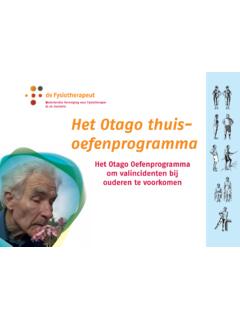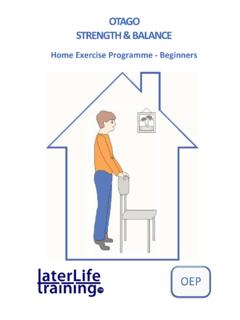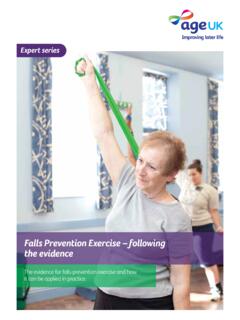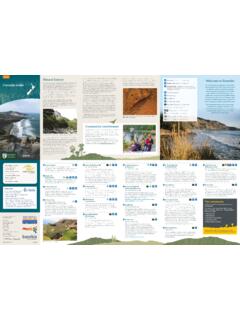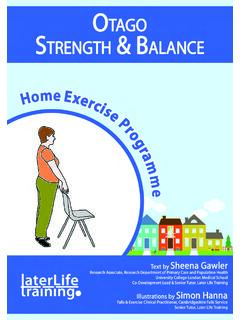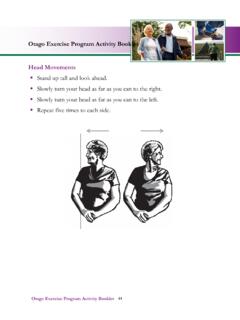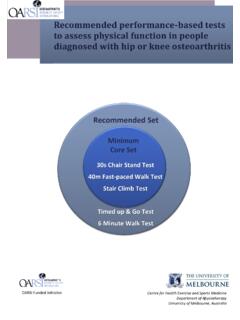Transcription of A CDC Compendium of Effective Fall Interventions
1 1A CDC Compendium of Effective Fall Interventions :What Works for Community-Dwelling Older Adults exercise -based InterventionsHome Modification InterventionsMultifaceted Interventions2nd EditionA CDC Compendium of Effective Fall Interventions :What Works for Community-Dwelling Older Adults 2nd EditionbyJudy A. Stevens, PhDDivision of Unintentional Injury PreventionNational Center for Injury Prevention and ControlCenters for Disease Control and Prevention (CDC)Atlanta, Georgia2010 This document is a publication of the National Center for Injury Prevention and Control of the Centers for Disease Control and PreventionCenters for Disease Control and PreventionThomas R.
2 Frieden, MD, MPH, DirectorNational Center for Injury Prevention and ControlLinda C. Degutis, DrPH, MSN, DirectorDivision of Unintentional Injury PreventionGrant Baldwin, PhD, MPH, DirectorHome and Recreation Injury Prevention TeamRita Noonan, PhD, Team LeaderAuthorJudy A. Stevens, PhDAcknowledgements for First EditionWe acknowledge and appreciate the contributions of Dr. Christine Branche who provided encouragement and unwavering support of this project; Dr. Patricia D. Nolan and Mr. DavidRamsey who developed the Compendium data base; and Ms. Lisa Jeanette who produced the initial draft. Acknowledgements for Second EditionWe acknowledge and appreciate the contributions of Ms.
3 Bonny Bloodgood and Ms. Sondra Dietz for their persistence in collecting data and drafting the second edition; and Dr. Rita Noonan, Dr. David Sleet and Dr. Michael Ballesteros who provided thoughtful and constructive Special AcknowledgementTo Dr. Ellen Sogolow, my co-author on the first edition, in appreciation of her foresight and leadership in developing the Compendium , a document that has been instrumental in promoting the dissemination and implementation of Effective evidence-based fall Interventions for older adults. Suggested Citation: Stevens JA. A CDC Compendium of Effective Fall Interventions : What Works for Community-Dwelling Older Adults.
4 2nd ed. Atlanta, GA: Centers for Disease Control and Prevention, National Center for Injury Prevention and Control, : Reference herein to any specific commercial products, programs, or services by trade name, trademark, manufacturer, or otherwise, does not necessarily constitute or imply its endorsement, recommendation, or favoring by the United States Government. The views and opinions of authors expressed herein do not necessarily state or reflect those of the United States Government and shall not be used for advertising or product endorsement The first edition of the CDC Compendium of Effective Fall Interventions (2008) was developed to give public health practitioners and aging services providers detailed information about Interventions that were scientifically proven to reduce falls in older adults.
5 The first edition included 14 studies of Effective falls Interventions that were published before 2005. The second edition maintains the original format study summaries, intervention descriptions, and summary tables and provides this information for 8 additional fall intervention studies published between 2005 and 2009. The 22 Interventions included in this second edition address a variety of audiences. Some are suitable for the very old ( , The otago exercise Programme), some are appropriate for specific populations such as the visually impaired ( , The VIP Trial), and others are designed for specific situations such as walking on ice and snow ( , Yaktrax Walker).
6 The Compendium will provide public health organizations and aging services providers with the information they need to identify Effective fall Interventions that are most appropriate for their communities particular needs, resources, and the Second Edition ContentsIntroduction ..1 exercise -based InterventionsStay Safe, Stay Active (Barnett, et al.) .. 6 The otago exercise Programme (Campbell, et al. and Robertson, et al. ) ..10 Erlangen Fitness Intervention (Freiberger, et al.) ..14 Tai Chi: Moving for Better Balance (Li, et al.) .. 16 Australian Group exercise Program (Lord, et al.) ..18 Yaktrax Walker (McKiernan) ..20 Veterans Affairs Group exercise Program (Rubenstein, et al.)
7 22 Falls Management exercise (FaME) Intervention (Skelton, et al.) ..24 Central Sydney Tai Chi Trial (Voukelatos, et al.) ..28 Simplified Tai Chi (Wolf, et al.) .. 30 Home Modification InterventionsThe VIP Trial (Campbell, et al.) ..34 Home Visits by an Occupational Therapist (Cumming, et al.) ..36 Falls-HIT (Home Intervention Team) Program (Nikolaus, et al.) .. 38 Multifaceted InterventionsStepping On (Clemson, et al.) .. 42 PROFET (Prevention of Falls in the Elderly Trial) (Close, et al.) .. 46 Accident & Emergency Fallers (Davison, et al.) ..48 The NoFalls Intervention (Day, et al.) .. 52 The SAFE Health Behavior and exercise Intervention (Hornbrook, et al.)
8 56 Multifactorial Fall Prevention Program (Salminen, et al.) ..60 The Winchester Falls Project (Spice, et al.) ..64 Yale FICSIT (Frailty and Injuries: Cooperative Studies of Intervention Techniques) (Tinetti, et al.) .. 68A Multifactorial Program (Wagner, et al.) ..72 Appendix A Intervention Study Selection Process ..75 Appendix B Bibliography of Compendium Studies ..81 Appendix C Tables ..89 Table 1 Overall Population Characteristics ..90 Table 2 Study Characteristics ..92 Table 3 Intervention Characteristics ..102 Appendix D Original Intervention Materials ..107 Appendix D-1 Barnett Materials ..109 Appendix D-2 Skelton Materials.
9 121 Appendix D-3 Voukelatos Materials ..125 Appendix D-4 Wolf Materials ..129 Appendix D-5 Close Materials ..133 Appendix D-6 Spice Materials ..1451 IntroductionOlder adults value their independence and a fall can significantly limit their ability to remain self-sufficient. More than one-third of people aged 65 and older fall each year, and those who fall once are two to three times more likely to fall again. Fall injuries are responsible for significant disability, loss of independence, and reduced quality of life. In 2000, direct medical costs for fall injuries totaled $19 billion. However, we know that falls are not an inevitable result of aging.
10 In recent years, systematic reviews of fall intervention studies have established that prevention Interventions can reduce falls. PurposeThe Centers for Disease Control and Prevention (CDC) developed the CDC Compendium of Effective Fall Interventions to help public health practitioners use the best scientific evidence to effectively address the problem of falls. The Compendium includes 22 specific Interventions for community-dwelling older adults that have rigorous scientific evidence of effectiveness, and provides relevant information about these Interventions to public health practitioners, aging service providers, and others who wish to implement fall prevention than one-third of people aged 65 and older fall each year, and those who fall once are two to three times more likely to fall ProcessCDC gathered information about science-based fall prevention intervention studies that met the following criteria.










